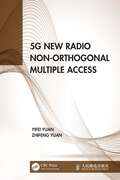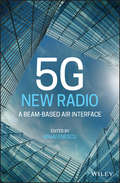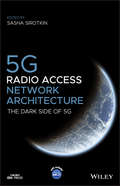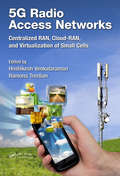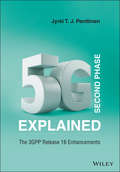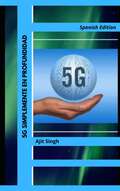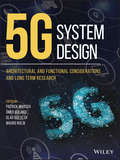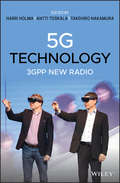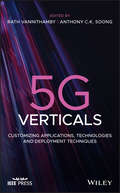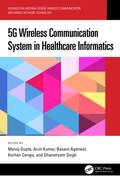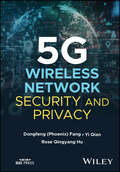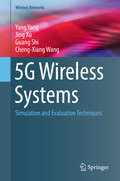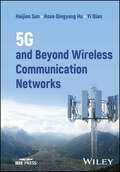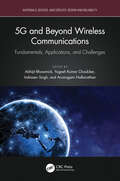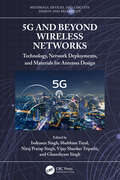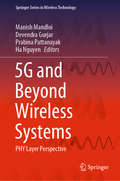- Table View
- List View
5G New Radio Non-Orthogonal Multiple Access
by Yifei Yuan Zhifeng YuanThis book provides detailed descriptions of downlink non-orthogonal multiple transmissions and uplink non-orthogonal multiple access (NOMA) from the aspects of majorly used 5G new radio scenarios and system performance. For the downlink, the discussion focuses on the candidate schemes in 3GPP standards which are not only applicable to unicast services but also to broadcast/multicast scenarios. For the uplink, the main target scenario is massive machine-type communications where grant-free transmission can reduce signaling overhead, power consumption of devices and access delays. The design principles of several uplink NOMA schemes are discussed in-depth, together with the analysis of their performances and receiver complexities. Devoted to the basic technologies of NOMA and its theoretical principles, data analysis, basic algorithms, evaluation methodology and simulation results, this book will be an essential read for researchers and students of digital communications, wireless communications engineers and those who are interested in mobile communications in general.
5G New Radio: A Beam-based Air Interface
by Mihai EnescuA guide to the 3GPP-specified 5G physical layer with a focus on the new beam-based dimension in the radio system 5G New Radio: A Beam-based Air Interface is an authoritative guide to the newly 3GPP-specified 5G physical layer. The contributors—noted experts on the topic and creators of the actual standard—focus on the beam-based operation which is a new dimension in the radio system due to the millimeter wave deployments of 5G. The book contains information that complements the 3GPP specification and helps to connect the dots regarding key features. The book assumes a basic knowledge of multi-antenna technologies and covers the physical layer aspects related to beam operation, such as initial access, details of reference signal design, beam management, and DL and UL data channel transmission. The contributors also provide a brief overview of standardization efforts, IMT-2020 submission, 5G spectrum, and performance analysis of 5G components. This important text: Contains information on the 3GPP-specified 5G physical layer Highlights the beam-based operation Covers the physical layer aspects related to beam operation Includes contributions from experts who created the standard Written for students and development engineers working with 5G NR, 5G New Radio: A Beam-based Air Interface offers an expert analysis of the 3GPP-specified 5G physical layer.
5G Non-Terrestrial Networks: Technologies, Standards, and System Design
by Alessandro Vanelli-Coralli Nicolas Chuberre Gino Masini Alessandro Guidotti Mohamed El Jaafari5G Non-Terrestrial Networks Provides a complete and detailed description of the non-terrestrial component in the 5G ecosystem 5G Non-Terrestrial Networks is the first multi-authored reference dedicated to the integration of non-terrestrial networks (NTN) into the 5G ecosystem. Written by leaders in the development of the 3GPP 5G NTN specification, this authoritative resource addresses all key aspects of non-terrestrial components of 5G systems, including standardization, architecture, protocols, and regulatory considerations. Drawing from their expertise in academic and industrial research and development, the authors introduce fundamental principles of non-terrestrial communications, define the NTN architecture and radio protocol stacks, describe applications to support mobility and radio resource management, and more. The book covers 5G New Radio-based technology for NTN as well as LTE NB-IoT/eMTC, providing a well-rounded understanding of the unique characteristics of 5G-NTN systems. Throughout the text, the authors offer insights on various design approaches, technical choices, and trade-off options. In addition, the book: Addresses the integration of non-terrestrial networks into 5G systems at all levels Describes the principles of non-terrestrial systems, including orbital parameters, link budget, propagation, and space/ground segments Includes a detailed overview of 5G-NTN system architectures, deployment scenarios, and spectrum aspects Covers NB-IoT and eMTC in NTN, NTN use cases, 5G QoS, and New Radio Discusses the potential of non-terrestrial components of 5G in the future 6G ecosystem 5G Non-Terrestrial Networks is a must-have for communication engineers, satellite network operators, aerospace and electrical engineers, network engineers, academic researchers and industry professionals involved in 5G infrastructure development, as well as advanced students taking courses on 5G and satellite communication.
5G Outlook – Innovations and Applications: Innovations And Applications (River Publishers Series In Communications Ser.)
by Ramjee Prasad5G Outlook - Innovations and Applications is a collection of the recent research and development in the area of the Fifth Generation Mobile Technology (5G), the future of wireless communications. Plenty of novel ideas and knowledge of the 5G are presented in this book as well as divers applications from health science to business modeling. The authors of different chapters contributed from various countries and organizations. The chapters have also been presented at the 5th IEEE 5G Summit held in Aalborg on July 1, 2016. The book starts with a comprehensive introduction on 5G and its need and requirement. Then millimeter waves as a promising spectrum to 5G technology is discussed. The book continues with the novel and inspiring ideas for the future wireless communication usage and network. Further, some technical issues in signal processing and network design for 5G are presented. Finally, the book ends up with different applications of 5G in distinct areas. Topics widely covered in this book are: • 5G technology from past to present to the future• Millimeter- waves and their characteristics• Signal processing and network design issues for 5G• Applications, business modeling and several novel ideas for the future of 5G
5G Physical Layer Technologies (Wiley - IEEE)
by Mosa Ali Abu-RgheffWritten in a clear and concise manner, this book presents readers with an in-depth discussion of the 5G technologies that will help move society beyond its current capabilities. It perfectly illustrates how the technology itself will benefit both individual consumers and industry as the world heads towards a more connected state of being. Every technological application presented is modeled in a schematic diagram and is considered in depth through mathematical analysis and performance assessment. Furthermore, published simulation data and measurements are checked. Each chapter of 5G Physical Layer Technologies contains texts, mathematical analysis, and applications supported by figures, graphs, data tables, appendices, and a list of up to date references, along with an executive summary of the key issues. Topics covered include: the evolution of wireless communications; full duplex communications and full dimension MIMO technologies; network virtualization and wireless energy harvesting; Internet of Things and smart cities; and millimeter wave massive MIMO technology. Additional chapters look at millimeter wave propagation losses caused by atmospheric gases, rain, snow, building materials and vegetation; wireless channel modeling and array mutual coupling; massive array configurations and 3D channel modeling; massive MIMO channel estimation schemes and channel reciprocity; 3D beamforming technologies; and linear precoding strategies for multiuser massive MIMO systems. Other features include: In depth coverage of a hot topic soon to become the backbone of IoT connecting devices, machines, and vehicles Addresses the need for green communications for the 21st century Provides a comprehensive support for the advanced mathematics exploited in the book by including appendices and worked examples Contributions from the EU research programmes, the International telecommunications companies, and the International standards institutions (ITU; 3GPP; ETSI) are covered in depth Includes numerous tables and illustrations to aid the reader Fills the gap in the current literature where technologies are not explained in depth or omitted altogether 5G Physical Layer Technologies is an essential resource for undergraduate and postgraduate courses on wireless communications and technology. It is also an excellent source of information for design engineers, research and development engineers, the private-public research community, university research academics, undergraduate and postgraduate students, technical managers, service providers, and all professionals involved in the communications and technology industry.
5G Radio Access Network Architecture: The Dark Side of 5G (Wiley - IEEE)
by Sasha SirotkinWritten by an industry insider with state of the art research at their fingertips, this book describes the Radio Access Network (RAN) architecture, starting with currently deployed 4G, followed by the description of 5G requirements and why re-thinking of the RAN architecture is needed to support these. Based on these considerations, it explains how 5G network architecture, which is currently being defined, is likely to evolve. The aim is not merely to cover relevant standards and technologies as a purely academic exercise (although a significant part of the book will be dedicated to these), but to augment these by practical deployment, to illustrate why the RAN architecture is changing and where it is going. With 5G deployments on the horizon, there is a desire within companies to both re-think the RAN architecture and to change the proprietary nature of the RAN. Correspondingly, there is increased interest in academia, standards bodies and commercial entities involved in the area.
5G Radio Access Networks: Centralized RAN, Cloud-RAN and Virtualization of Small Cells
by Ramona Trestian Hrishikesh VenkatarmanC-RAN and virtualized Small Cell technology poses several major research challenges. These include dynamic resource allocation, self-configuration in the baseband pool, high latency in data transfer between radio unit and baseband unit, the cost of data delivery, high volume of data in the network, software networking aspects, potential energy savings, security concerns, privacy of user’s personal data at a remote place, limitations of virtualized environment, etc. This book provides deeper insights into the next generation RAN architecture and surveys the coexistence of SDN, C-RAN and Small Cells solutions proposed in the literature at different levels.
5G Second Phase Explained: The 3GPP Release 16 Enhancements
by Jyrki T. J. Penttinen5G SECOND PHASE EXPLAINED A one-stop reference that offers an accessible guide to an understanding of the enhanced core technologies of 5G 5G Second Phase Explained – The 3GPP Release 16 Enhancements offers an authoritative and essential guide to the new functionalities of the Release 16 that complement the first phase of the 5G. From the author of 5G Explained comes the next step resource that includes detailed descriptions that provide a clear understanding to the full version of the 5G technologies and their impacts on the Phase 1 networks.The author—an industry expert—not only reviews the most up-to-date functionalities of the Release 16 but includes information on the forthcoming Release 17 as well as material on future developments. The book explores the highly unique aspects of the Release 16, which can help technical personnel’s efforts to deliver essential information in a practical way. The two books, 5G Explained and 5G Second Phase Explained, offer a comprehensive understanding of 5G. This important guide:Offers a summary of the newest and key features of 5GPresents a one-stop reference for an understanding of the core technologies of 5GContains a new book that expands on the author’s 5G ExplainedPuts the focus on security and deployment aspects of 5G enhancementsWritten for technical personnel of network operators, network element and user device manufacturers, 5G Second Phase Explained offers a guide to an understanding of network deployment and device designing of 5G technologies.
5G Simplemente en Profundidad
by Ajit Singh5G Technologies es una visión y definición de la Tecnología 5G es introducida, así como varias técnicas clave que permiten la Tecnología 5G. Este libro provee un panorama de las características clave de la quinta Generación (5G) de redes móviles, discutiendo la motivación para 5G, arquitectura, implementación, modelos de referencia, retos en el desarrollo de esta nueva tecnología. Este libro provee una vista dentro de las áreas clave de desarrollo que definirán este nuevo sistema tecnológico, preparando la ruta a través de investigación futura y desarrollo. Este libro pretende cubrir el panorama 5G, incluyendo Internet Futuro, computación en nube, celdas pequeñas y redes auto-organizadas (SONs), comunicaciones cooperativas, y radio cognitivo, convergencia radio difusión-banda ancha, retos de seguridad 5G. Facilidades clave: • Aborda los fundamentales de redes móviles 5G, sirviendo como una guía de estudio para investigadores e ingenieros de sistemas móviles con el objetivo de posicionar su investigación en este escenario de rápida evolución. • Desarrolla la historia de celdas pequeñas junto con la nueva generación de sistemas SON (redes auto-organizadas) como soluciones para dirigir la demanda de tráfico sin precedente y variaciones a través de celdas. • Explica la tecnología de Nube Móvil y Servicios par plataformas futuras de comunicación. • Discute los temas abiertos encarando la implementación a escala comercial amplia de redes de espacio blanco, incluyendo el potencial para aplicaciones hacia el estándar futuro de 5G. • Describe los componentes clave, tendencias y retos, así como los requerimientos de sistemas para transceivers de 5G a radios de soporte multi estándar, una fuente de inspiración por los ingenieros de RF. Este libro serviría como una guía ideal para B.E., B.Tech., B.S., B.Sc, B.C.A., estudiantes univers
5G System Design: An End to End Perspective (Wireless Networks)
by Wan Lei Liu Jianghua Wu Yong Brian Classon Weimin Xiao David Mazzarese Zhao Yang Tony Saboorian Anthony C.K. SoongThis book presents a detailed pedagogical description of the 5G commercial wireless communication system design, from an end to end perspective, by those that were intimate with its development. The exposition only assumes that the reader is passingly familiar with LTE and builds upon that knowledge. By comparing and contrasting NR with LTE, it allows for quick mastering of 5G. As such it gives concise and highly accessible description of the key technologies in the 5G physical layer, radio access network layer protocols and procedures, how the 5G core and EPC is integrated into the radio access network, how virtualization, slicing and edge computer will fundamentally change the way we interact with the network, as well as 5G spectrum issues.The 2nd edition of this book significantly enhances and updates the first edition by adding 5G security and Release-16 developments. Loosely speaking, 5G Release-15 can be characterized as being optimized for the cellular carrier eMBB service while 5G Release-16 is the beginning of the optimization of 5G for the vertical industries. It mainly focused on the support of the vehicular vertical and Industrial Internet of Things. As such, we have significantly altered the first edition to cover the key features standardized in Release-16 including: URLLC, V2X, IIoT, enhanced MIMO, unlicensed access, positioning, power savings and IAB. On the network side, detailed discussion covers NR security as well as the newly standardized access traffic steering, non 3GPP access switching and splitting features, non 3GPP access network support and private networks.Engineers, computer scientists and professionals from those with a passing knowledge of 4G LTE to experts in the field will find this book to be a valuable asset. They will gain a comprehensive understanding of the end to end 5G commercial wireless system. Advanced-level students and researchers studying and working in communication engineering, who want to gain an understanding of the 5G system (as well as methodologies to evaluate features and technologies intended to supplement 5G) will also find this book to be a valuable resource.
5G System Design: Architectural and Functional Considerations and Long Term Research
by Patrick Marsch Ömer Bulakci Olav Queseth Mauro BoldiThis book provides a comprehensive overview of the latest research and standardization progress towards the 5th generation (5G) of mobile communications technology and beyond. It covers a wide range of topics from 5G use cases and their requirements, to spectrum, 5G end-to-end (E2E) system architecture including core network (CN), transport network (TN) and radio access network (RAN) architecture, network slicing, security and network management. It further dives into the detailed functional design and the evaluation of different 5G concepts, and provides details on planned trials and pre-commercial deployments across the globe. While the book naturally captures the latest agreements in 3rd Generation Partnership Project (3GPP) New Radio (NR) Release 15, it goes significantly beyond this by describing the likely developments towards the final 5G system that will ultimately utilize a wide range of spectrum bands, address all envisioned 5G use cases, and meet or exceed the International Mobile Telecommunications (IMT) requirements for the year 2020 and beyond (IMT-2020). 5G System Design: Architectural and Functional Considerations and Long Term Research is based on the knowledge and consensus from 158 leading researchers and standardization experts from 54 companies or institutes around the globe, representing key mobile network operators, network vendors, academic institutions and regional bodies for 5G. Different from earlier books on 5G, it does not focus on single 5G technology components, but describes the full 5G system design from E2E architecture to detailed functional design, including details on 5G performance, implementation and roll-out.
5G Technology: 3GPP Evolution to 5G-Advanced
by Antti Toskala Harri Holma Takehiro Nakamura5G TECHNOLOGY An Essential Insider’s View of the Development Work of 5G Technology Up to Release 18 5G brings new technology solutions to the 5G mobile networks, including new spectrum options, antenna structures, physical layer and protocols designs, and network architectures. 5G Technology: 3GPP Evolution to 5G-Advanced is an accessible and comprehensive resource that offers explanations of 5G specifications and performance evaluations, aspects of device design, practical deployment considerations and illustrative examples from field experiences. With contributions from a panel of international experts on the topic (industry insiders working at the forefront of development), the book presents the main new technology components in 5G and describes the physical layer, radio protocols, and network performance indicators associated with them. It has intentionally been written to cater to individuals at all levels of 5G expertise. Some of the topics of discussion and learning resources in the work include: An easy-to-understand insider’s overview of 5G from editors and authors who are actively working with the 5G development in 3GPP, the forum defining the requirements Deployment aspects, such as site density and transport network, plus exploration into 5G performance aspects, including data rates, coverage, and latency A large number of illustrations including simulation and measurement results of 5G technology performance, plus key 5G procedures Updated information on industrial IoT, radio enhancements in Releases 16 and 17, open RAN and virtualized RAN, 5G verticals and new use cases, and the 5G-Advanced development in Release 18 and outlook towards Release 19 5G Technology: 3GPP Evolution to 5G-Advanced serves as a complete resource for wireless researchers, network planners, lecturers in universities, technology analysts, R&D engineers, application developers, and spectrum regulators who wish to thoroughly understand the latest in 5G technology and get ahead of the curve with regards to its potential applications in a wide variety of industries.
5G Technology: 3GPP New Radio
by Harri HolmaA comprehensive guide to 5G technology, applications and potential for the future 5G brings new technology solutions to the 5G mobile networks including new spectrum options, new antenna structures, new physical layer and protocols designs and new network architectures. 5G Technology: 3GPP New Radio is a comprehensive resource that offers explanations of 5G specifications, performance evaluations, aspects of device design, practical deployment considerations and illustrative examples from field experiences. With contributions from a panel of international experts on the topic, the book presents the main new technology components in 5G and describes the physical layer, radio protocols and network performance. The authors review the deployment aspects such as site density and transport network and explore the 5G performance aspects including data rates and coverage and latency. The book also contains illustrative examples of practical field measurement. In addition, the book includes the most recent developments in 4G LTE evolution and offers an outlook for the future of the evolution of 5G. This important book: Offers an introduction to 5G technology and its applications Contains contributions from international experts on the topic Reviews the main technology components in 5G Includes information on the optimisation of the Internet of things Presents illustrative examples of practical field measurements Written for students and scientists interested in 5G technology, 5G Technology: 3GPP New Radio provides a clear understanding of the underlying 5G technology that promotes the opportunity to take full benefit of new capabilities.
5G Verticals: Customizing Applications, Technologies and Deployment Techniques
by Rath Vannithamby Anthony C.K. SoongA comprehensive text to an understanding the next generation mobile broadband and wireless Internet of Things (IoT) technologies 5G Verticals brings together in one comprehensive volume a group of visionaries and technical experts from academia and industry. The expert authors discuss the applications and technologies that comprise 5G verticals. The earlier network generations (2G to 4G) were designed as on-size-fits-all, general-purpose connectivity platforms with limited differentiation capabilities. 5G networks have the capability to demand customizable mobile networks and create an ecosystem for technical and business innovation involving vertical markets such as automotive, healthcare, manufacturing, energy, food and agriculture, city management, government, public transportation, media and more. 5G will serve a large portfolio of applications with various requirements ranging from high reliability to ultra-low latency going through high bandwidth and mobility. In this book, the authors explore applications and usages of various 5G verticals including a set of key metrics for these uses and their corresponding target requirements. The book also examines the potential network architectures and enabling technologies to meet the requirements of 5G verticals. This important book: Offers a comprehensive resource to the promise of 5G Verticals Provides a set of key metrics for the uses and target requirements Contains illustrative examples of the technology and applications Includes contributions from experts in the field and professionals that developed the 5G standards Provides an analysis of specific vertical industries which have the potential to be among the first industries to use 5G Written for industry practitioners, engineers and researchers, 5G Verticals discusses the technology that enables the 5G system to be flexibly deployed and scaled.
5G Wireless Communication System in Healthcare Informatics (Advances in Antenna Design, Wireless Communication and Mobile Network Technology)
by Manoj Gupta Basant Agarwal Ghanshyam Singh Arun Kumar Korhan CengizThis text discusses problems and needs with the implementation of a 5G mobile communications system in the healthcare sector. It covers the issues related to advanced modulation schemes, telehealth, and remote diagnosis. It discusses important topics including virtual healthcare monitoring, spectrum sensing techniques, the role of 5G in medical applications, the role of nano- communication in healthcare informatics, and remote diagnosis. The text will be useful for graduate students, academic researchers, and professionals in the fields of electrical, and electronics and communication engineering, and allied healthcare. This book: Discusses novel architecture to manage the allocation of resources, and the interference issue among existing and advanced radios Provides focus to estimate the performance, cost and accommodation of the next generation technology design for the IoT, modern health- care, and education Covers advanced technologies and their role in healthcare Discusses key topics including spectrum access, advanced waveforms, which can help in standardization of 5G based smart hospital Explores the impact of telemedicine in smart healthcare This reference text covers the latest advances in the field of 5G mobile communication for healthcare informatics, addressing both original algorithm development and new applications of 5G mobile Communications.
5G Wireless Network Security and Privacy (IEEE Press)
by Yi Qian Rose Qingyang Hu DongFeng Fang5G WIRELESS NETWORK An expert presentation of 5G security, privacy, and network performance In 5G Wireless Network Security and Privacy, a team of veteran engineers delivers a robust and accessible discussion of 5G security solutions, including physical layer security, authentication, and mobility management. In the book, the authors expertly cover the requirements of 5G wireless network security and privacy, with explorations of existing solutions and vulnerabilities from security architecture and mechanism perspectives. Readers will learn how to enhance the security and network performance of 5G wireless networks in contexts like vehicle‐to‐vehicle and vehicle‐to‐infrastructure communications, industrial automation, health services, smart cities, and smart homes. They will develop a comprehensive understanding of 5G wireless network security as they move through the book’s 11 insightful chapters, developing in‐depth knowledge on the current state of 5G security and coming developments in the field. Readers will also find: A thorough introduction to legacy cellular network security, including network performance development from 1G to 4G In‐depth treatments of 5G network security, including the motivation and objectives of 5G wireless network security Comprehensive explorations of wireless security solutions, including cryptographic approaches and physical layer security Fulsome discussions of the security architecture of cellular networks, including 3G and 4G security Perfect for researchers and professionals working in the field of cybersecurity and 5G wireless networks, 5G Wireless Network Security and Privacy will also earn a place in the libraries of engineers, computer scientists, and graduate students studying 5G network security and privacy.
5G Wireless Systems: Simulation and Evaluation Techniques (Wireless Networks)
by Yang Yang Jing Xu Guang Shi Cheng-Xiang WangThis book focuses on key simulation and evaluation technologies for 5G systems. Based on the most recent research results from academia and industry, it describes the evaluation methodologies in depth for network and physical layer technologies. The evaluation methods are discussed in depth. It also covers the analysis of the 5G candidate technologies and the testing challenges, the evolution of the testing technologies, fading channel measurement and modeling, software simulations, software hardware cosimulation, field testing and other novel evaluation methods. The fifth-generation (5G) mobile communications system targets highly improved network performances in terms of the network capacity and the number of connections. Testing and evaluation technologies is widely recognized and plays important roles in the wireless technology developments, along with the research on basic theory and key technologies. The investigation and developments on the multi-level and comprehensive evaluations for 5G new technologies, provides important performance references for the 5G technology filtering and future standardizations. Students focused on telecommunications, electronic engineering, computer science or other related disciplines will find this book useful as a secondary text. Researchers and professionals working within these related fields will also find this book useful as a reference.
5G and Beyond (Springer Tracts in Electrical and Electronics Engineering)
by Bharat Bhushan Raghvendra Kumar Sudhir Kumar Sharma Ishaani PriyadarshiniThis open-access book aims to highlight the coming surge of 5G network-based applications and predicts that the centralized networks and their current capacity will be incapable of meeting the demands. The book emphasizes the benefits and challenges associated with the integration of 5G networks with varied applications. Further, the book gathers and investigates the most recent 5G-based research solutions that handle security and privacy threats while considering resource-constrained wireless devices. The information, applications, and recent advances discussed in this book will serve to be of immense help to practitioners, database professionals, and researchers.
5G and Beyond Wireless Communication Networks (IEEE Press)
by Yi Qian Rose Qingyang Hu Haijian Sun5G and Beyond Wireless Communication Networks A comprehensive and up-to-date survey of 5G technologies and applications In 5G and Beyond Wireless Communication Networks, a team of distinguished researchers deliver an expert treatment of the technical details of modern 5G wireless networks and the performance gains they make possible. The book examines the recent progress in research and development in the area, covering related topics on fundamental 5G requirements and its enabling technologies. The authors survey 5G service architecture and summarize enabling technologies, including highly dense small cell and heterogeneous networks, device-to-device communications underlaying cellular networks, fundamentals of non-orthogonal multiple access in 5G new radio and its applications. Readers will also find: A thorough introduction to 5G wireless networks, including discussions of anticipated growth in mobile data traffic Comprehensive explorations of dense small cell and heterogeneous networks Practical discussions of the most recent developments in 5G research and enabling technologies Recent advancement of non-orthogonal multiple access and its role in current and future wireless systems Perfect for graduate students, professors, industry professionals, and engineers with an interest in wireless communication, 5G and Beyond Wireless Communication Networks will also benefit undergraduate and graduate students and researchers seeking an up-to-date and accessible new resource about 5G networks.
5G and Beyond Wireless Communications: Fundamentals, Applications, and Challenges (Materials, Devices, and Circuits)
by Arumugam Nallanathan Indrasen Singh Abhijit Bhowmick Yogesh Kumar ChoukikerThis book provides a thorough introduction of 5G and B5G wireless networks, as well as cutting-edge technologies that aid in network design and development. This book also covers machine learning techniques for advanced communications.5G and Beyond Wireless Communications: Fundamentals, Applications, and Challenges discusses the newest technologies for 5G and future networks, including CR networks, D2D networks, UAV-assisted communications, RIS-assisted communications, and ML for communication networks. Additionally, it discusses using antenna systems for advanced communications networks. It also explores various security issues and their solutions, as well as power and interference management and machine learning for optimization of network parameters. The book also examines the design of 5G antennas from a materials perspective, and a thorough analysis of the materials utilized to create innovative antennas for advanced communication network is discussed. The book concludes by discussing the advancement of ML-based communication networks and their future opportunities and challenges.This book will be helpful for researchers and master students who want to focus their research work in the area of next-generation advanced wireless communications.
5G and Beyond Wireless Networks: Technology, Network Deployments, and Materials for Antenna Design (Materials, Devices, and Circuits)
by Ghanshyam Singh Shubham Tayal Vijay Shanker Tripathi Indrasen Singh Niraj Pratap Singh5G and Beyond Wireless Networks: Technology, Network Deployments, and Materials for Antenna Design offers a comprehensive overview of 5G and beyond 5G wireless networks along with emerging technologies that support the design and development of wireless networks. It also includes discussions on various materials used for practical antenna design which are suitable for 5G, beyond 5G applications, and cell-free massive MIMO systems.The book discusses the latest techniques used in 5G and beyond 5G (B5G) communication, such as non-orthogonal multiple access (NOMA), device-to-device (D2D) communication, 6G ultra-dense O-RAN, rate-splitting multiple access (RSMA), simultaneous wireless information and power transfer (SWIPT), massive multiple input multiple output (mMIMO), and cell-free massive MIMO systems, which are explained in detail for 5G and beyond cellular networks. The description of NOMA and their benefit for 5G and beyond networks is also addressed along with D2D communication for next generation cellular networks. RSMA technique is also explained for 6G communication. Detailed descriptions for the design and development of 5G and beyond networks over various techniques are included. The materials specification to design antenna for 5G application are also given.The role of metalens in designing effective antennas and material specifications for 5G applications is explained in this book. Apart from the above emerging topics, this book also gives ideas about intelligent communication, Internet of Multimedia Things (IOMT), millimeter-wave MIMO-UFMC, and fog computing cloud networks. The last chapter gives details about the legal frameworks for 5G technology for responsible and sustainable deployment. Overall, this book may benefit network design engineers and researchers working in the area of next generation cellular networks.The contents of this book will be helpful for young researchers and master students, and network design engineers who are working in the area of next generation cellular networks.
5G and Beyond Wireless Systems: PHY Layer Perspective (Springer Series in Wireless Technology)
by Manish Mandloi Devendra Gurjar Prabina Pattanayak Ha NguyenThis book presents the fundamental concepts, recent advancements, and opportunities for future research in various key enabling technologies in next-generation wireless communications. The book serves as a comprehensive source of information in all areas of wireless communications with a particular emphasis on physical (PHY) layer techniques related to 5G wireless systems and beyond. In particular, this book focuses on different emerging techniques that can be adopted in 5G wireless networks. Some of those techniques include massive-MIMO, mm-Wave communications, spectrum sharing, device-to-device (D2D) and vehicular to anything (V2X) communications, radio-frequency (RF) based energy harvesting, and NOMA. Subsequent chapters cover the fundamentals and PHY layer design aspects of different techniques that can be useful for the readers to get familiar with the emerging technologies and their applications.
5G and Beyond Wireless Transport Technologies: Enabling Backhaul, Midhaul, and Fronthaul
by Douglas H MoraisThis text covers the key technologies employed in wireless links that enable increased data rates and thus are likely to be employed in support of 5G wireless transport networks, i.e., backhaul, midhaul, and fronthaul networks. The author presents technologies at an introductory level but nonetheless at a level that imparts to the reader a sound understanding of the fundamentals. The book is intended for those practicing engineers and graduate and upper undergraduate students who have an interest in acquiring, where missing, the necessary technology background in order to comprehend the functioning and capability of 5G based wireless transport links. The author focuses on those technologies that are key to achieving the high data rates and high reliability required of this transport. The material is presented in a clear, concise, and mathematically light fashion.Covers key wireless transport (backhaul, midhaul, and fronthaul) technologies for 5G and beyond, presented in a clear tractable fashion;Outlines the basic wireless transport transmitter/receiver terminal architecture, provides specifications of some such terminals, and indicates the link performance afforded by such terminals;Provides sufficient mathematics to make it technically coherent, but not so much as to make it challenging for a reader with no or limited familiarity with these technologies.
5G and Beyond: Fundamentals and Standards
by Xingqin Lin Namyoon LeeThis book provides an accessible and comprehensive tutorial on the key enabling technologies for 5G and beyond, covering both the fundamentals and the state-of-the-art 5G standards. The book begins with a historical overview of the evolution of cellular technologies and addresses the questions on why 5G and what is 5G. Following this, six tutorial chapters describe the fundamental technology components for 5G and beyond. These include modern advancements in channel coding, multiple access, massive multiple-input and multiple-output (MIMO), network densification, unmanned aerial vehicle enabled cellular networks, and 6G wireless systems. The second part of this book consists of five chapters that introduce the basics of 5G New Radio (NR) standards developed by 3GPP. These include 5G architecture, protocols, and physical layer aspects. The third part of this book provides an overview of the key 5G NR evolution directions. These directions include ultra-reliable low-latency communication (URLLC) enhancements, operation in unlicensed spectrum, positioning, integrated access and backhaul, air-to-ground communication, and non-terrestrial networks with satellite communication.
5G and E-Band Communication Circuits in Deep-Scaled CMOS (Analog Circuits and Signal Processing)
by Patrick Reynaert Marco VigilanteThis book discusses design techniques, layout details and measurements of several key analog building blocks that currently limit the performance of 5G and E-Band transceivers implemented in deep-scaled CMOS. The authors present recent developments in low-noise quadrature VCOs and tunable inductor-less frequency dividers. Moreover, the design of low-loss broadband transformer-based filters that realize inter-stage matching, power division/combining and impedance transformation is discussed in great detail. The design and measurements of a low-noise amplifier, a downconverter and a highly-linear power amplifier that leverage the proposed techniques are shown. All the prototypes were realized in advanced nanometer scaled CMOS technologies without RF thick to metal option.
